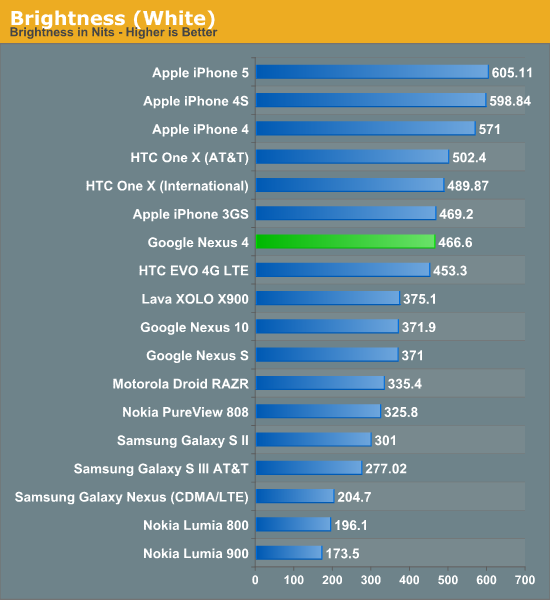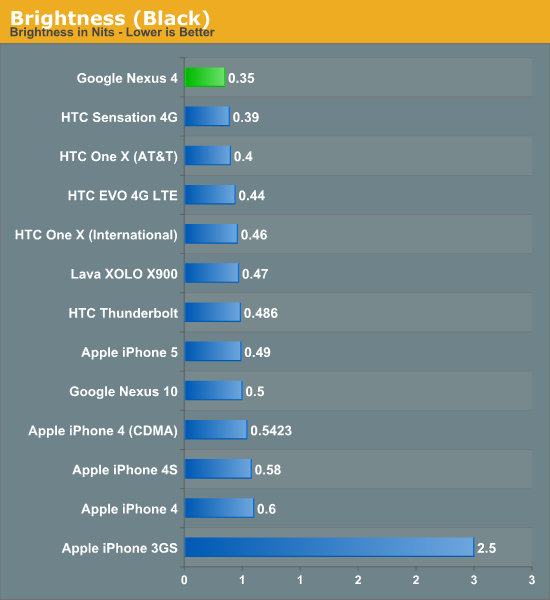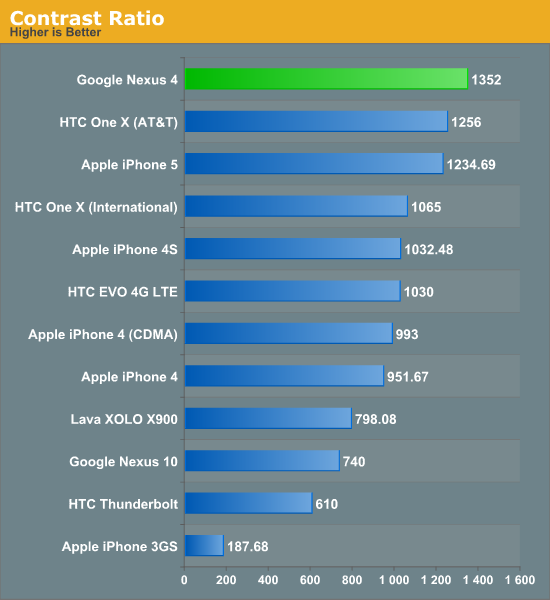Google Nexus 4 Review - Google's new Flagship
by Brian Klug on November 13, 2012 8:45 AM EST- Posted in
- Smartphones
- LG
- Android
- Mobile
- APQ8064
- Nexus 4
- Android 4.2
- MDM9215
The display on the Nexus 4 is another shared component between the Optimus G, and is a 4.7-inch IPS WXGA (1280x768) LCD, which is of course home to an RGB stripe and in-cell touch, or as LG calls it, "zerogap" touch. LG Display unsurprisingly knows how to make LCD displays, and the Nexus 4 display looks subjectively very good. At 320 PPI I can’t see any pixels, and don’t think we need to get into the whole visual acuity discussion again, it’s very good on the Nexus 4. The added width over straight 720p is something I noted was actually very refreshing on the Optimus G when playing with that device in Korea. Most apps scale appropriately and take advantage of it without any issue, and the extra width definitely is noticeable in Chrome, Plume, and all my daily drivers.



The Nexus 4 display goes very bright, at 466 nits, and achieves a contrast ratio of 1352:1 at that maximum brightness setting. This is a huge step over the barely 200 nits that the Galaxy Nexus could eek out.
| CalMAN Display Comparison | |||||||||
| Metric | iPhone 5 | iPhone 4S | HTC One X | Samsung Galaxy S 3 | Samsung Galaxy Note 2 | Google Nexus 4 | |||
| Grayscale 200nits Avg dE2000 | 3.564 | 6.162 | 6.609 | 4.578 | 5.867 | 7.686 | |||
| CCT Avg (K) | 6925 | 7171 | 5944 | 6809 | 7109 | 8506 | |||
| Saturation Sweep Avg dE2000 | 3.591 | 8.787 | 5.066 | 5.460 | 7.986 | 8.517 | |||
| GMB ColorChecker Avg dE2000 | 4.747 | 6.328 | 6.963 | 7.322 | 8.185 | 7.531 | |||
I’ve mentioned that Google continues to struggle at calibrating their displays. The truth is that everyone except for Apple, HTC, and occasionally Samsung, struggle at calibrating mobile displays. This continues to be the case with the Nexus 4, and the result is that accuracy could be better. I’m convinced the results that we’re getting out of the Nexus 4 basically represent no attempt at calibrating the display, and as a result the numbers suffer.
















188 Comments
View All Comments
zeroidea - Wednesday, November 14, 2012 - link
It's Tucson, AZ!They must have been taken a few weeks ago (a lot of the streetcar construction downtown has been completed)
DukeN - Tuesday, November 13, 2012 - link
Brian, are you able to verify if the material is actually rubber? This would be a serious issue for many users, including some in my family with severe latex allergies.PeteH - Tuesday, November 13, 2012 - link
Wow, that didn't even occur to me, but it could be a real problem. It's not like latex is an uncommon allergy either, so hopefully Google or LG thought about that and used something other than rubber.Rits - Tuesday, November 13, 2012 - link
Its rubberised plastic. Shouldn't be a problem at all to latex-allergic folks.PeteH - Tuesday, November 13, 2012 - link
Not doubting you, but do you have a source?Rits - Tuesday, November 13, 2012 - link
Previous LG devices that had the same material were latex-free. There is no reason this one would deviate. But, you could always email LG/Google for an official confirmation.MadMan007 - Tuesday, November 13, 2012 - link
Should have used a dual core CPU with a decent GPU. Quad core is a waste in phones because overall it hurts battery life more than it helps certain usage models, and if there's so much throttling what's the point.Does Android do thread parking? Do these CPUs have per-core power gating?
JohnnyL53 - Tuesday, November 13, 2012 - link
Throttling may not be an issue in the real world in terms of a noticeable affect and may just show up in benchmarks. In other words, who cares what the benchmark performance is if its at such a high level it's not perceptible? What I never see explained is how far apart do you need to get before you can distinguish one device's performance from another. Granted on most of the tests the iPhone far outpaces any other phone, but is it even noticeable? Are we just talking bragging rights, future proofing, etc?name99 - Tuesday, November 13, 2012 - link
The value of a faster CPU on a phone, for normal people, right now, is that the phone feels snappier. So, for example, an iPhone5 feels perceptibly faster than an iPhone 4S not because computational tasks take 1 minute instead of 2 minutes, but because a dozen small things take .1 second instead of .2 seconds.From this point of view
(a) thermal throttling is no big deal, and I personally have no problem with it. It was a good idea when Intel started it years ago (to the accompaniment of a massive chorus of whining) and it would be a fine idea to have it as built into an ever wider selection of phone chips.
(b) quad-core remains a solution in search of a problem. Maybe one day it will have value; maybe it has value for games (which I don't care about). But for the way I and my crowd use phones, it has no value yet.
(c) the present collection of benchmarks are largely useless because they do NOT track this essence of snappiness which is what most people mean when they say a phone is "fast". Yes, if you're a developer writing demanding code you care about very particular aspects of the phone --- perhaps you care about the memory bandwidth, or the FLOPs, or the random flash write performance. But for most people, what matters is the snappiness. Existing benchmarks are a poor proxy for that feeling, and I do wish the serious blogs could do better.
Right now all we have is this lame sniping like 12 yr olds: "My Nokia feels fast", "Oh yeah, well my Samsung feels even faster", "Well my iPhone feels fastest of all". And regardless of your feelings about Apple, if you support Team Android or Team Windows, you should be pushing for snappiness benchmarks because that is one of Apple's great strengths --- they don't care about, and don't optimize for benchmark numbers, they optimize for snappiness, and buyers do appear to be aware of and notice this. As long as the non-Apple market is forced to compete on these "overt" benchmarks as ways for each vendor to differentiate themselves and show their technical superiority, what will be optimized for are benchmark numbers, NOT user feel and snappiness.
Zink - Tuesday, November 13, 2012 - link
I think with a DSLR at 60 FPS and editing to synchronize individually recorded videos it would be possible to do accurate side by side comparison of app responsiveness and web page loads. With a bit of video analysis, graphs could be made comparing performance down to the frame and FPS in animations measured.You could even do this on the go for a real world performance comparison. A normal day of use could be simulated by walking/commuting around your city and setting up a tripod in an apartment, on the sidewalk, inside an office building, at the bar etc. Then run several tests on each phone where you get the phone out of your pocket like normal and open a web page, post a comment, take a photo etc. all while the screen is on camera. Several similar tasks could be averaged into a single category score for a bit better repeatability.
With proper analysis of the resulting video a pretty damn accurate comparison of the whole cellular, hardware and software system could be made. Basically the ultimate benchmark measuring user phone performance. I've seen some well done side by side comparisons but never in depth or with good numbers along with the video.